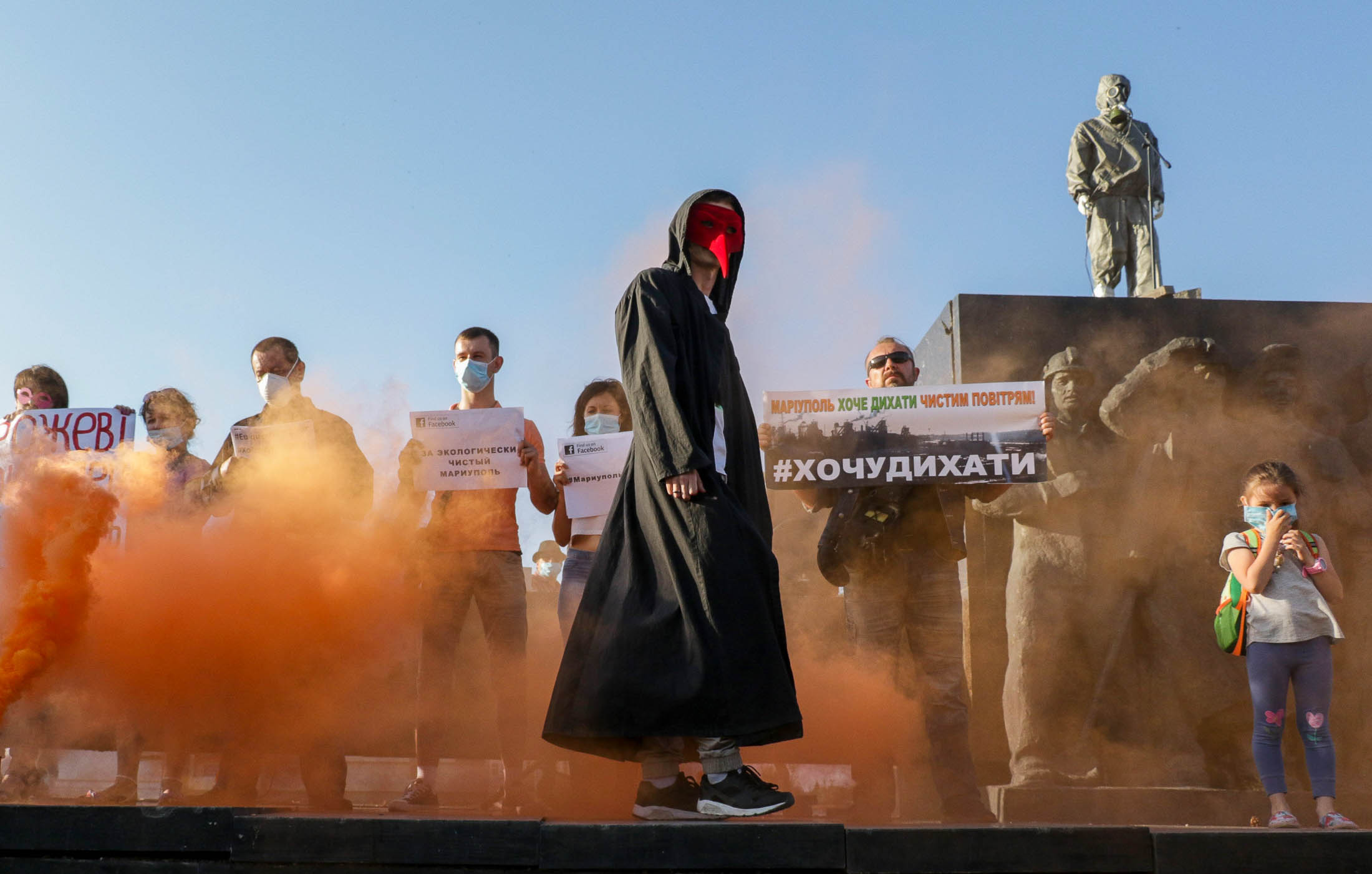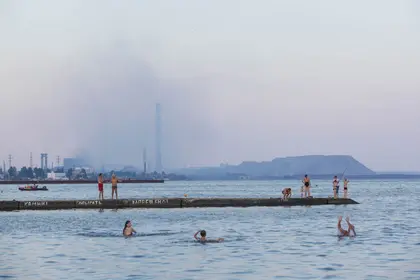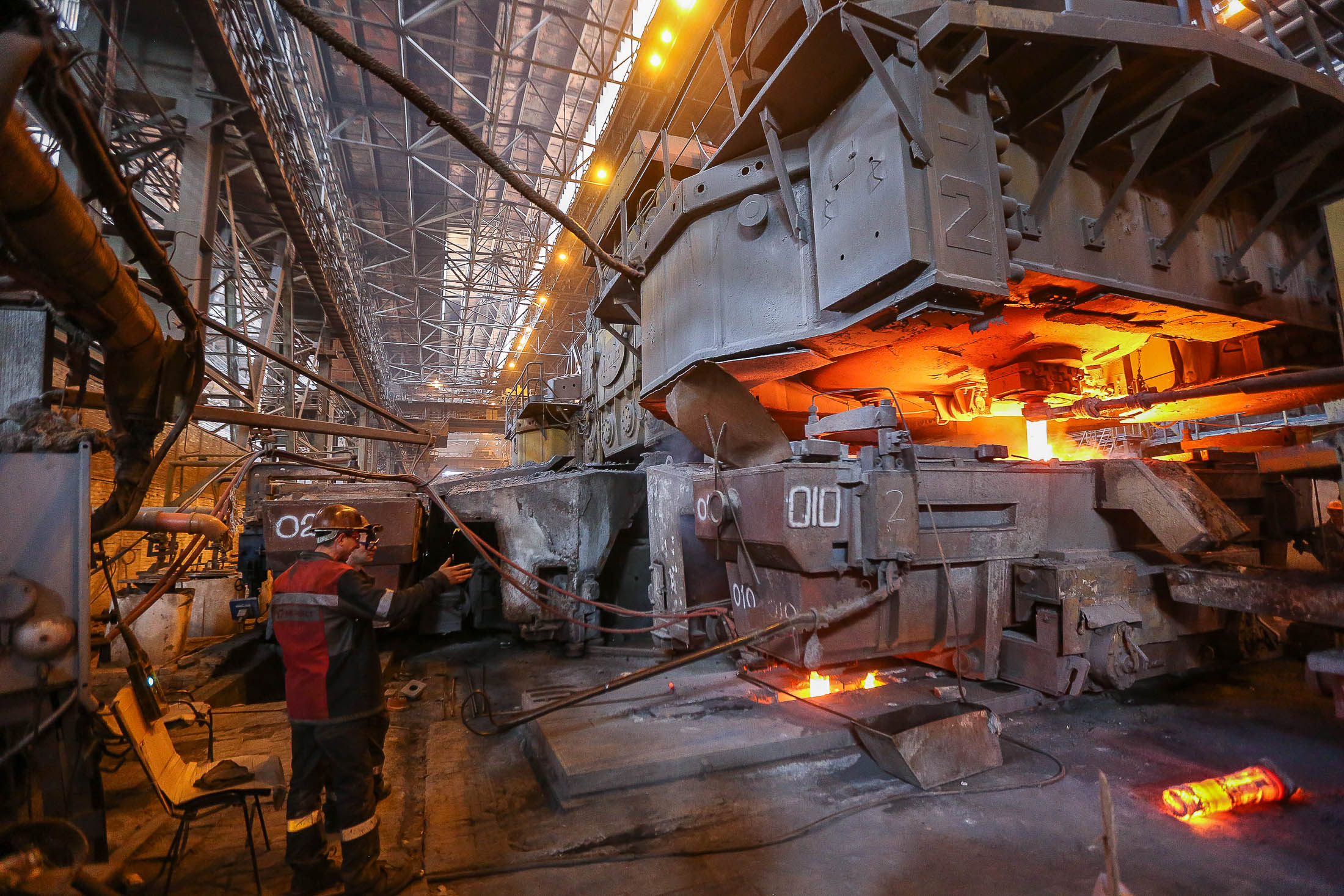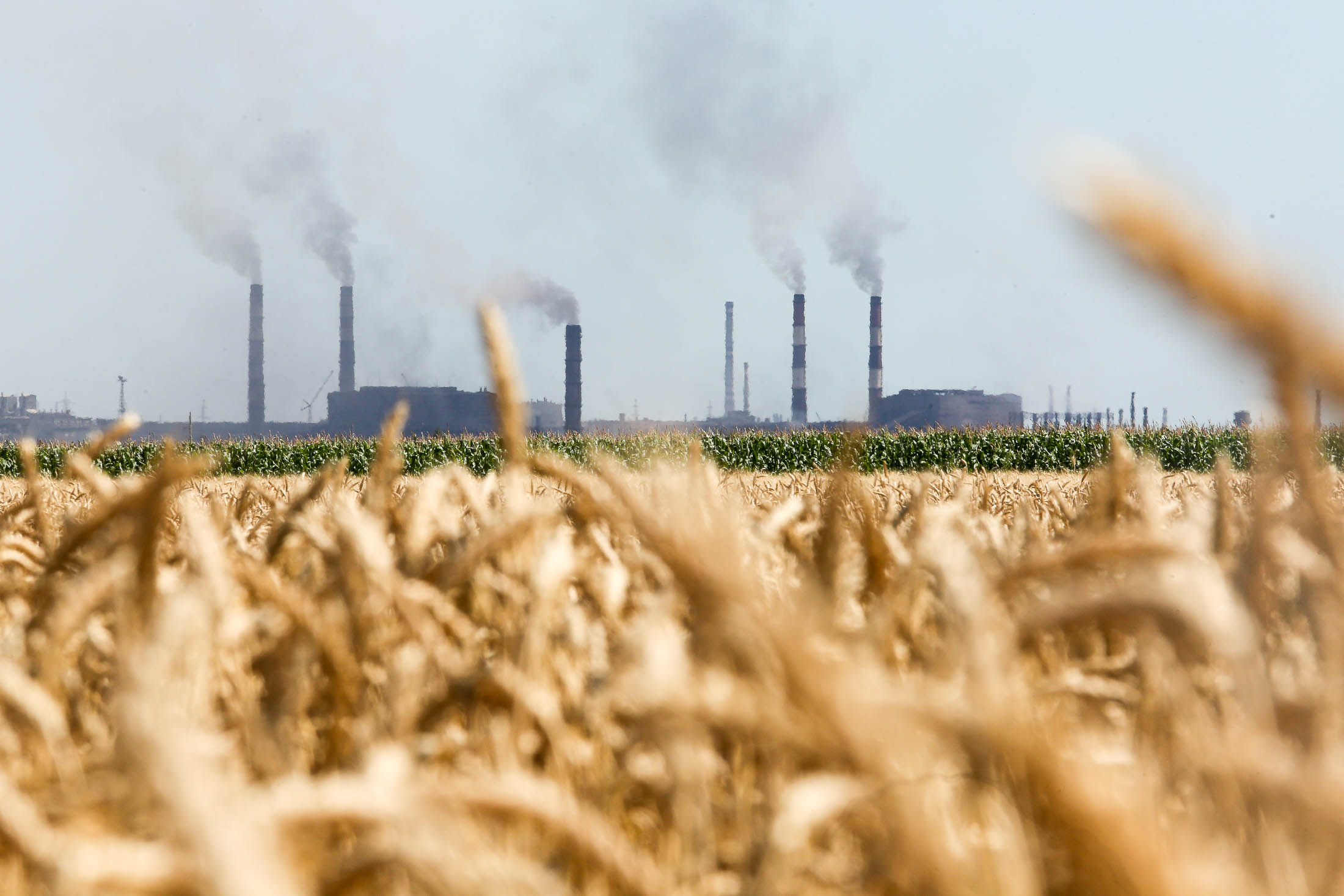MARIUPOL, Ukraine — The people of Mariupol are under threat from the ground — Russian-led forces are only around a dozen kilometers away, well within striking range of this city of 450,000 people some 640 kilometers southeast of Kyiv.
And there is a growing threat from the sea, as Russia tightens its control over the waters of the Azov Sea, effectively blockading the Ukrainian ports along the sea’s coast.
JOIN US ON TELEGRAM
Follow our coverage of the war on the @Kyivpost_official.
But the danger the city’s residents fear the most comes from the air. The 121-year-old Ilyich Iron and Steel Works Plant and the 85-year-old Azov Stal steel plant belch fumes from their chimneys day and night.
Both plants belong to the Metinvest Group. The company, owned by the wealthiest man in Ukraine, billionaire oligarch Rinat Akhmetov, has even earned the nickname “Smertinvest” (Deathinvest) from locals, such is the level of pollution generated by its industrial behemoths in the city.
Metinvest did not respond to a request for comment.
Thanks to the two plants, the air in Mariupol is the dirtiest among the country’s 39 biggest cities, according to a pollution study carried out in August by the Kyiv-based Central Geophysical Observatory. The most dangerous contaminants include formaldehyde and particles of metal dust.
The plants are a double-edged sword for Mariupol. While they pollute the air that people in Mariupol breathe, they also provide about 35,000 jobs to them.
There is also another cost: the unhealthy influence that Metinvest wields over local politics.
“Mariupol is a city of influence for Metinvest,” said Valeriy Averiyanov, a local environmental activist and one of the organizers of the “I Want to Breath” flash mob in Mariupol, which attracted more than 1,000 people on June 5.
Under the pressure from the locals, Metinvest vowed to invest in new filtration systems for its two plants. But activists fear that the growth of production will outpace this modernization, and pollution will go on.

Investing in influence
The two plants are easily visible on satellite images as big brown wounds on the cityscape — the Ilyich plant to the north and Azov Stal in the south, next to the sea. A massive slag heap, 30–40 meters high and dubbed by locals “The Slag Mountain,” rises over Azov Stal altering the skyline and threatening to slip into the sea: A berm around its edge contains a pond of foul, bluish-green water polluted with chemicals and metals.
Most days, a filthy smog hangs over the plants, and at night flares of fire burst from Azov Stal’s smoke stacks, lighting up the clouds of smoke over the plant with an orange glow.
Although Metinvest purchased Azov Stal in 2006, and the Ilyich Plant in 2010, Averiyanov, like many other activists and locals, believes Metinvest only took the full control over Mariupol, as well as other eastern industrial cities like Kryviy Rih and Zaporizhia, in 2015. That was after the corporation lost a major part of its assets in Russian-occupied Donetsk following the start of the war in 2014.
“Metinvest invested more than Hr 1 billion into political campaigns in these cities during local elections in 2015,” Averiyanov told the Kyiv Post. “As a result, former Metinvest managers have become lawmakers with influence in local councils.”
The former head of Metinvest HR department Vadym Boychenko became the mayor of Mariupol in 2015. He says on the local council website that he has been completely independent of Metinvest since the election.
Olena Makhova, the Mariupol city council spokesperson, said that claims that Metinvest has political control over the city were rumors, and refused to comment further. There is no denying the Metinvest plants are vital for the local economy.
Makhova said the Metinvest’s two plants contribute 23 percent of the city budget in taxes every year. The corporation is taking an active part in the development of the city, investing millions in the reconstruction of schools, hospitals, and other projects.
And Azov Stal and Ilyich Plant have already paid more than Hr 121 million in ecological taxes to the state this year, with 25 percent of that sum going to the local budget.
Top polluters
Both Azov Stal and the Ilyich Plant are among the worst polluters of Ukraine’s environment. According to a ranking on the Ukrainian Ecology Ministry’s website, Ilyich is the country’s second worst emitter of air pollution after the ArcelorMittal steel plant in Kryviy Rih. Azov Stal is the 11th worst air polluter, but it is also the country’s worst polluter of water.
According to the latest data available, in 2016 alone Ilyich Plant produced more than 1.7 million tons of dangerous emissions to the atmosphere.
Azov Stal produced 78,600 tons of atmospheric pollutants, and poured 1.4 million cubic meters of waste into the Azov Sea.
In 2018 Ukraine’s Health Ministry warned the public to avoid swimming at any of the beaches around Mariupol.
The level of pollution has produced a public reaction: more than 2,000 Mariupol residents protested for cleaner air in the city in June, calling on Akhmetov to modernize the filtration systems at both of the city’s metal producers.
Metinvest has promised to invest more than $318 million by 2020 into modernization, and plans to decrease dust emissions in the city by more than 10 times, reads a statement posted on Metinvest’s official website in June 2017.
However, according to local lawmaker an environmental activist Maksym Borodin, Akhmetov’s plants are increasing their production levels at such a pace that the modernization work is having little effect.
So far this year Mariupol’s metal plants increased production of cast iron by 14 percent and production of steel by 8 percent in comparison to 2017. Borodin says the pollution also increased.
“Ilyich Plant has the biggest sinter factory in Ukraine, with 12 blast furnaces,” Borodin said. “They’ve upgraded only three. Last month they launched a massive filtration system. But we’ve noted that the new filters have been turned off and on.”
Borodin said that Ilyich Plant has promised to install filters and upgrade all 12 blast furnaces by the end of 2018.
Ongoing problem
Borodin has been fighting for better air in his native Mariupol for more than six years. He said that the situation has slightly improved compared to 2012, when Azov Stal stopped its facilities for a month after thick smog blanketed the city.
Every day Borodin and his team measure the level of metal dust and other atmospheric pollution in the various districts of the city.
The activists said that pollution was a problem in Mariupol long before Akhmetov purchased the plants. In 2012, major protests in the city forced Metinvest to close one of the sinter plants located in the city center.
Soon after that, Metinvest started modernizing. Then, in 2015, the AzovMash engineering plant in the city center was also closed. This has slightly improved the environmental situation in the city.
“Today it depends on the wind. But residents of the districts close to the plants suffer from intensified air pollution five days a week. And during the night the emissions are worse.”
Health consequences
People in Mariupol have already got used to planning their daily life with an eye to the level of emissions from the plants.
Using the mobile app BreezoMeter, locals monitor air contamination levels to decide whether it is safe to spend the day outside. People still go to the beaches of Mariupol to enjoy the Azov Sea under the smoking chimneys of the Azov Stal plant on the coast. The plant uses seawater to cool its equipment and metal products. The wastewater heats the sea around the output pipes by several degrees.
At night, when Azov Stal is smelting metal, the plant’s chimneys periodically spew fire, and when the plants are operating at full capacity, a thick smog covers part of the city. During the weekends, when production slows down, people can enjoy some clean skies and breath some air.
“The reddish-brown smoke from the pipes of the plants is the worst,” said Borodin. “That means they are evaporating metals. The very fine PM 2.5 fraction (particulate matter, 2.5 micrometers in diameter on average) is very dangerous. It gets into people’s lungs and straight into the blood.”
According to Borodin, too many Mariupol residents are suffering from various blood diseases, and many other ailments caused by the pollution.
According to the official data provided by Mariupol City Council Health-Care department to the Kyiv Post, in 2017 more than 122,000 residents of Mariupol complained of various infections of the respiratory tract, including pharyngitis and tracheitis.
About 13,000 people were treated for skin diseases, and there were 1,880 registered cases of cancer in 2017.
Those figures probably don’t show the full scale of the problem, Borodin said, as many people don’t even seek medical help.
He said that the locals understand that the outmoded plants are poisoning Mariupol, but they also provide a living to thousands of families, so they don’t want them to shut down.
“But the plants, as dangerous objects of production, have to assume their responsibilities, and we must all oversee them, and push them in order to make Mariupol a safe place to live,” Borodin said.
You can also highlight the text and press Ctrl + Enter









